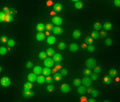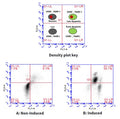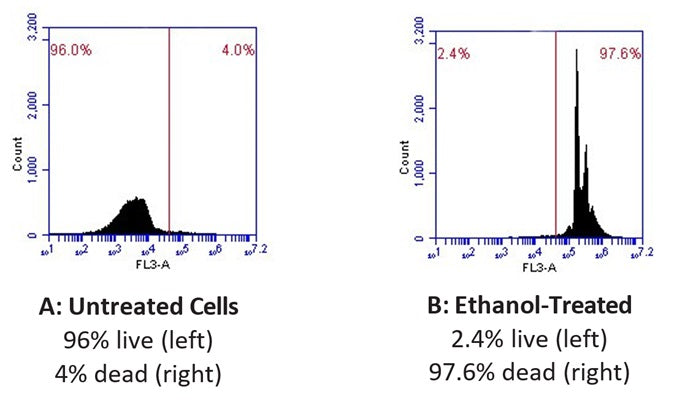Ships: 1-2 business days
- Reconstitute the vial of 7-AAD with 0.26 mL DMSO to create a stock concentrate at 1 mg/mL. Mix by swirling or tilting the vial, allowing the DMSO to travel around the base of the amber vial until completely dissolved. At room temperature, the reagent should be dissolved within a few minutes forming a red solution. 2. If storing the stock concentrate for future use, prepare small aliquots (50 µL) to avoid freeze-thaw cycles. The stock concentrate will be stable for 6 months when protected from light and stored at or below -20°C.
- Expose cells to the experimental conditions.
- Create 2 control tubes: untreated viable cells and untreated killed cells. These cells will be stained with 7-AAD to compensate the flow cytometer to ensure that dead cells shift along the FL3 axis. These controls will also determine the level of spontaneous cell death that normally occurs within the cell line when compared with the treated cells.
- Stain cells at a final concentration of 5 µg/mL of 7-AAD in the cell culture. This can be accomplished by pipetting the stock solution directly into the cell suspension at 1:200; e.g., add 2 µL stock to 400 µL cell suspension. This can also be accomplished by diluting the stock concentrate 1:10 to form the working solution, and then pipetting the working solution into the cells at 1:20. For example, add 50 µL 7-AAD stock concentrate into 450 µL PBS or sterile media. Mix by inverting or vortexing the vial at room temperature. Store on ice up to 2 hours. Then add the working solution to the cell suspension at approximately 1:20; e.g., put 25 µL diluted 7-AAD working solution into 475 µL cell suspension.
- Incubate 10-30 minutes on ice.
- If desired, wash cells twice with PBS and fix in 1% paraformaldehyde.
- Analyze with a flow cytometer: excitation at 546 nm; emission at 647 nm in FL3. Dead cells with compromised membranes will appear red.
Product Specific References
| PMID | Publication |
| 38443460 | Goswami, N, et al. 2024. EVATOM: an optical, label-free, machine learning assisted embryo health assessment tool. Communications biology, 268. |





